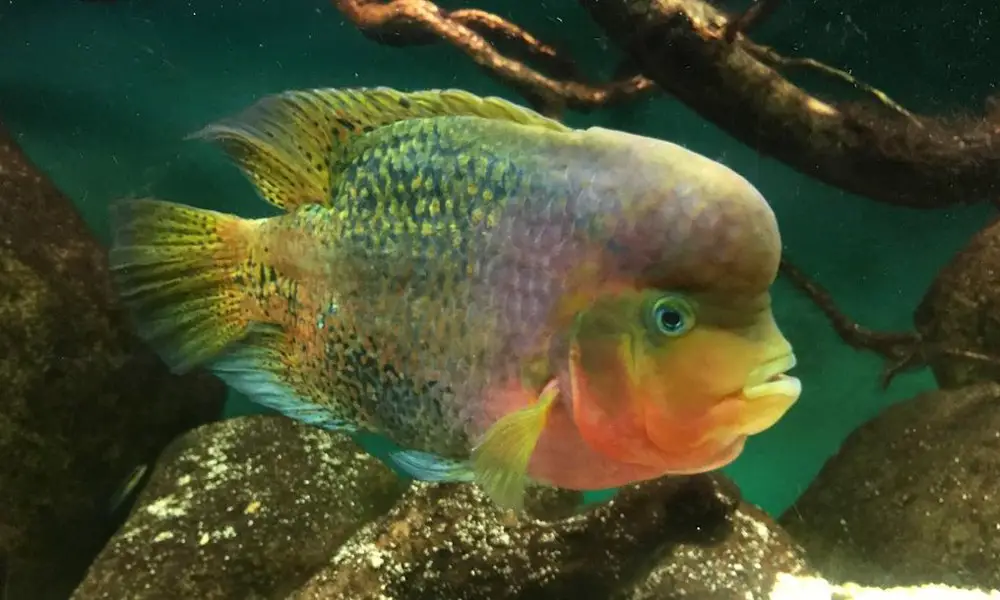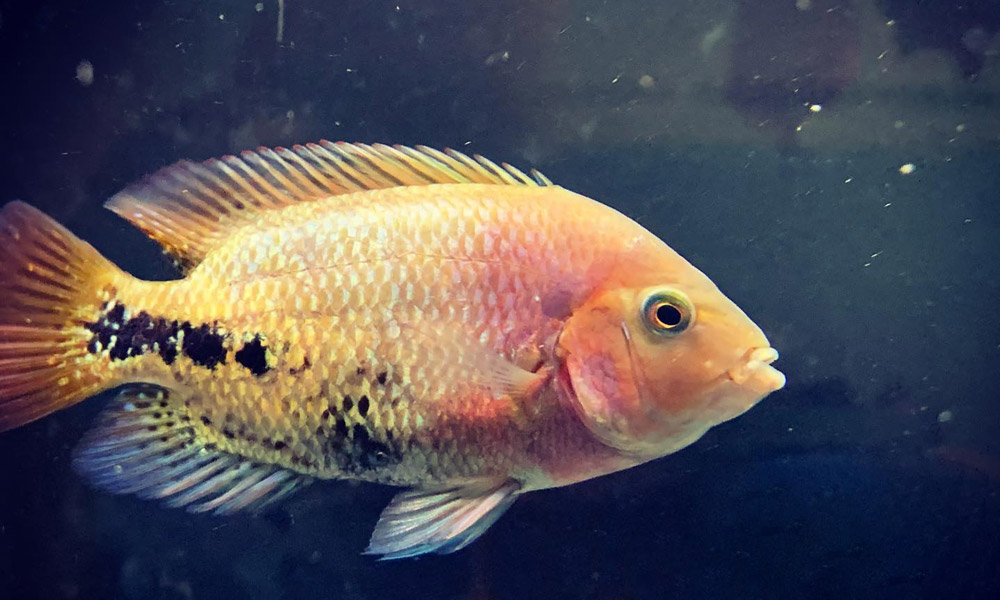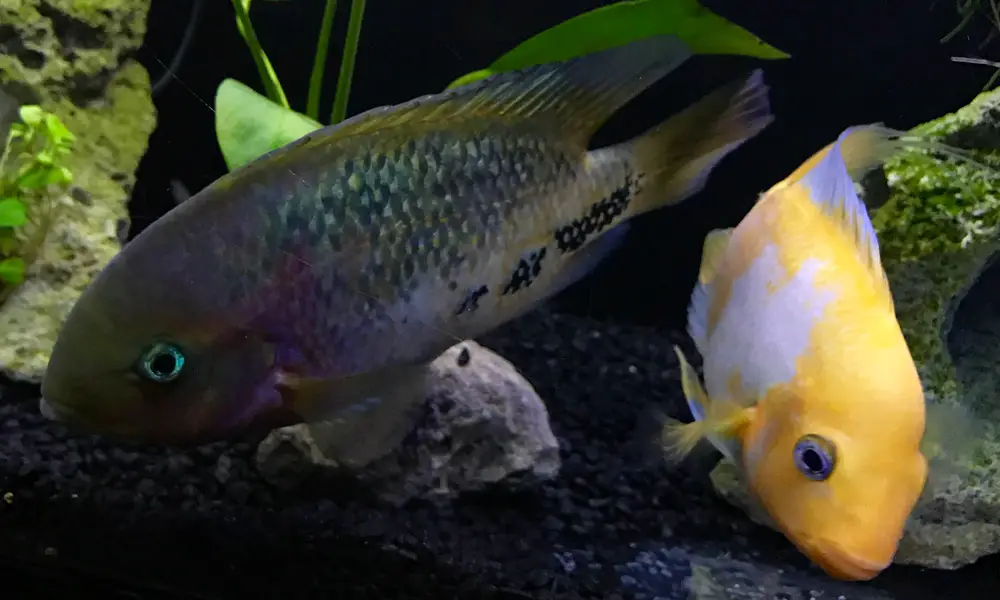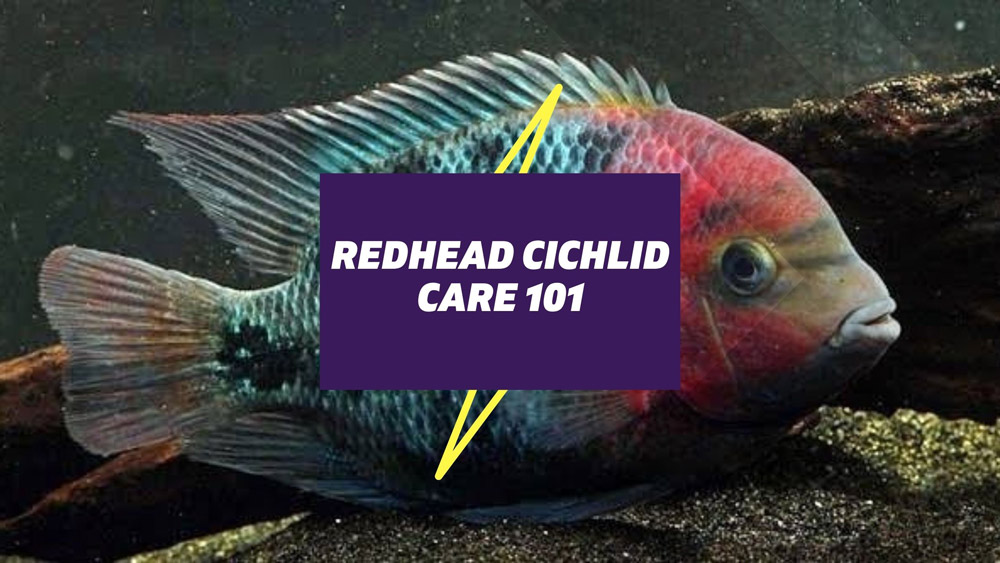The Redhead is an excellent choice if you’re looking for a stunning and large fish for your Central and South American cichlid aquarium. From their striking pastel color to their relative temperament, they really break the mold!
For those of you who want to keep this fish in your home aquarium, there are many things you should know. The lack of information on its care can be frustrating.
So, without further ado, here is everything you need to know about Redhead cichlids!
Basic Info

The Redhead cichlid (Vieja melanurus), also known as the quetzal cichlid or Firehead cichlid, is a large and beautiful freshwater fish native to muddy and slow-moving waters in Central America.
The species of the genus Vieja are deeper-bodied cichlids, there are eight species have been described:
- Vieja bifasciata (Steindachner, 1864) (Twoband cichlid)
- Vieja breidohri (U. Werner & Stawikowski, 1987) (Angostura cichlid)
- Vieja fenestrata (Günther, 1860)
- Vieja guttulata (Günther, 1864) (Amatitlan cichlid)
- Vieja hartwegi (J. N. Taylor & R. R. Miller, 1980) (Tailbar cichlid)
- Vieja maculicauda (Regan, 1905) (Blackbelt cichlid)
- Vieja melanurus (Günther, 1862) (Redhead cichlid)
- Vieja zonata (Meek, 1905) (Oaxaca cichlid)
Most originate from freshwater except for the Vieja maculicauda (Blackbelt cichlid), which is also found in slightly brackish water.
Redhead cichlids are popular among aquarists and also be seen on sale as their previous name: Vieja synspilum. However, according to a recent genetic study, Vieja synspilum is the same fish as Vieja melanurus.
| Scientific Name: | Vieja melanurus |
| Common Name: | Redhead Cichlid, Quetzal cichlid, Firehead cichlid, Synspilum cichlid |
| Origin: | Central America |
| Care Level: | Experienced |
| Lifespan: | 10 to 15 years |
| Size: | 14″ |
| Temperature: | 76-86°F |
| PH: | 7.5 – 8 |
| Water hardness: | 10 – 15 dGH |
| Diet: | Herbivorous |
| Minimum Tank Size: | 70 gallons |
| Temperament: | Semi-aggressive |
Appearance
As their name would suggest, an adult male Redhead cichlid is easily recognizable by its brilliant red-orange (or yellow) forehead and large nuchal hump.
Their basic coloration can range from reddish-brown to a mix of green, gold, and blue tunes, depending on where they were originally found.
The dorsal, caudal, and anal fins are edged in different colors, and the caudal fin is slightly rounded. Juvenile specimens typically have several vertical black stripes running along the body.
Adult males tend to be larger than females and are much brighter. They also have extended dorsal and anal fins. The most identifying characteristics for mature males are the pronounced nuchal hump on their forehead and a pointed genital papilla.
Redhead Cichlid Size

The Redhead cichlid can grow quite large, up to 14 inches (35 cm) in length in the wild and up to 16 inches (40.6 cm) in captivity. In public aquariums where the Redhead cichlids are displayed, they can reach lengths of 30 inches.
Due to their large size, you need to make sure you have a spacious aquarium that can accommodate their adult size. We cover the recommended tank size in the following section.
Redhead Cichlid Lifespan
The average lifespan of a Redhead cichlid is between 10 to 15 years. This age is usually only attainable in optimal tank conditions with a quality diet.
To ensure your Redhead cichlid lives a long and healthy life, it’s important to provide them with a clean and spacious aquarium as well as a quality diet that meets their nutritional needs.
Care and Tank Setup
Redhead cichlids are very majestic and long-lived species that are definitely worth your time and effort to care for them properly. Here are some tips on setting up your Redhead cichlid aquarium and providing the best care possible.
Aquarium Size
As we mentioned before, Redhead cichlids can grow quite large, so you need to make sure you have a spacious tank.
The recommended tank size for a single adult Redhead cichlid is at least 70 gallons long tank. If you plan on keeping a breeding pair, we recommend a tank size of at least 120 gallons. For aquarists who like to keep a group of juvenile fish (more than four) together to obtain a pair, go for 135 gallons or bigger.
Of course, a larger tank is always better to allow your Redhead cichlids more space to swim and explore. The extra space can also help reduce aggression levels and prevent territorial issues, giving your Redhead cichlids a more stress-free environment.
Water Conditions
As with all large Central and South American cichlids, these fish are very adaptable and can live in a wide range of water conditions and even withstand slight brackish water conditions. There is currently no evidence that they can live in moderate brackish water conditions for a long time.
To keep your fish healthy, try to replicate these water conditions as closely as possible in your aquarium. Here are some guidelines:
- Water Temperature: 76 – 86°F (24 – 30°C)
- pH: 7.0
- Water Hardness: 10 – 15°H
Whether you’re a beginner or an experienced keeper, we always recommend regularly testing your water parameters to ensure they stay within the optimal range. This will help you catch any potential issues early on and prevent them from affecting the health of your fish.
Filtration & Heater
As Redhead cichlids are large and active fish, they produce a lot of waste, so a powerful filtration system is essential to keep the water quality high. Additionally, these fish do best in peat-filtered water.
As for heating, we recommend using an aquarium heater to maintain a consistent water temperature whether you’re living in a warm or cold climate. Redhead cichlids are tropical fish; they prefer water on the warmer side.
Also, make sure to do water changes 2 or 3 times per week to remove the buildup of ammonia and nitrates.
Substrate & Tank Decorations
The Redhead cichlid is a digger; it’s best to use a sandy substrate or small rounded gravel in their aquarium. They will also appreciate plenty of rocks, caves, and driftwood as hiding places, but make sure to leave an open swimming area.
As for tank decorations, these fish tend to rearrange decor, be sure those decor items are firm enough that they won’t collapse.
If you have live plants, there is a big chance your Redhead cichlid will consume or uproot them as they are almost entirely herbivorous. In general, Redhead cichlids are not considered plant-friendly fish.
However, many owners have had success with well-rooted, hard plants surrounded by sturdy rocks.
Food & Diet
Redhead cichlids are primarily herbivorous but also take a small number of live foods. In the wild, their diet consists of plant matter, small crustaceans, and insects.
In captivity, they are not picky eaters and will accept a variety of foods. To keep your Redhead cichlid healthy and provide them with all the nutrients they need, we recommend giving them a varied diet that includes both plant-based and meaty foods.
A high-quality cichlid pellet or flake food as the base diet is your best bet. However, you should also offer up some protein-rich snacks to boost their beautiful colors and help them reach their full potential.
Some good options include live or frozen foods such as brine shrimp, bloodworms, blackworms, and krill. You can also feed them blanched vegetables such as zucchini, broccoli, and spinach a couple of times a week.
Temperament and Behaviors
As a member of the cichlid family, the Redhead cichlid is moderately aggressive. Lowering aggression levels can be done by keeping them in a large tank or a group of 4 or more.
These large fish have a powerful bite and can be extremely aggressive and territorial towards their own kind. They are also known to be nippy, and it’s best not to keep them with smaller or more delicate fish.
Redhead Cichlid Tank Mates

Due to their natural aggression and big sizes, choosing suitable tank mates for Redhead cichlids can be a bit tricky.
Redhead cichlids will be quite happy in pairs. A bonded pair is the safest option when you want to keep Redhead cichlids in your aquarium. To obtain a breeding pair, you can either buy a group of juveniles and let them grow up together or buy an already mated pair from your LFS.
If you decide to keep more than one Redhead cichlid, we recommend at least four individuals so they can form their own hierarchy within the group and reduce aggression levels.
The potential tank mates for Redhead cichlids in a community aquarium are robust, similar-sized Central American cichlids. Depending on your fish’s personality and the environment you provide, they can all live in harmony eventually.
As long as you have a large enough tank, here are some suitable species to try out:
- Chocolate Cichlid
- Severum Cichlid
- Bristlenose Pleco
- Tiger Barbs
- Lemon Tetras
- Corys
Breeding
As you might know, the Redhead cichlid (Vieja melanurus) has been used in breeding new hybridized species for quite some time, such as the flowerhorn cichlids and blood parrot cichlids.
Redhead cichlid breeding is relatively simple once you have a mated pair. These fish are substrate spawners. The female Redhead cichlid will lay her eggs (up to 1200 eggs) on a cleaned flat surface such as a slate rock.
After that, the male Redhead cichlid will come along and fertilize them.
The eggs will hatch in 2-3 days, and the fry will be free swimming a week after that. The parents will protect the fry for a few weeks, but it’s best to remove them from the tank as they can be quite aggressive if they are ready to breed again.
To prevent the parents from eating their own offspring, it’s best to move them to a separate breeding tank. You can feed the fry with live foods such as brine shrimp and microworms. You can start giving them crushed flakes or pellets as they grow older.
The main challenge for Redhead cichlid breeding is to get a mated pair as they always have pairing problems. Again, the best way to achieve this is to buy a group of juveniles and let them grow up together. With any luck, you will end up with a breeding pair.
Conclusion
The Redhead cichlid is a beautiful and unique fish that will make a great addition to any freshwater aquarium. They are relatively easy to care for as long as you provide them with the right environment and diet.
If you’re thinking about adding Redhead cichlids to your tank, then it’s probably a good idea to purchase a bonded pair or a group of juveniles so they can form their own pairs at their own pace.
If you have any suggestions on what other fish species can be Redhead cichlid tank mates or have any experiences with these beautiful fish that you would like to share, please leave a comment below.
Happy fish keeping!
